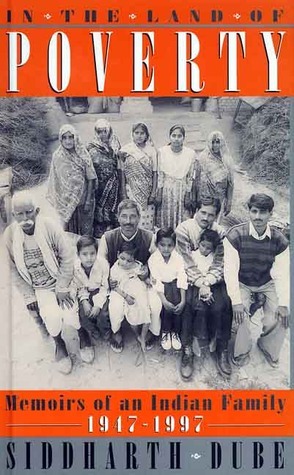The Memoirs of an Indian Family, 1947-1997

What have fifty years of freedom meant for the poor of India? Is India destined to remain the land of poverty? By sheer numbers alone, the history of India’s poor is India’s history and this history is compellingly recorded in In the Land of Poverty.
An unforgettable oral history of an impoverished Indian family, In the Land of Poverty draws readers into an understanding not just of the personal experience of poverty but of the intractable reasons for its continuance.
On 15 August 1947, the day of India‘s independence from Britain, Ram Dass Pasi and his family were ‘Untouchables’ – lowest of the low in an apparently unchanging caste system, landless serfs bonded to a feudal village lord in a remote part of Uttar Pradesh deep in the heartland of India. Fifty years later as the country celebrated its half-century of independence, Ram Dass‘s family still suffered poverty and oppression – this despite their efforts and despite the changes which have transformed the face of independent India.
This book is their story – and the story of modern India. Told through the voices of several generations, In the Land of Poverty takes the reader on a journey into the reality of South Asian poverty – the powerlessness, the sickness, the illiteracy and all the other deprivations which enmesh the poor. Gradually we learn to understand not simply the human reality of what it means to be poor, but also the central paradox of modern India: half a century of democracy, economic growth and constitutional commitment to social justice has not lessened the acute, mass poverty of the country.
Reviews for In the Land of Poverty
A deeply illuminating study of poverty in India, seen in concrete detail and made vividly real by remarkable descriptive skill.
Amartya Sen | Nobel laureate in economics
Ram Dass’ stories are heartrending, despite the fact that neither he nor his transliterator seek to manipulate their audience; it is their simplicity that is so devastatingly effective.
Pankaj Mishra | The Times Literary Supplement
An extraordinary study of the human dimensions of poverty and development.
Shashi Tharoor | Author of Inglorious Empire: What the British Did to India
A sensitive, ideology-free analysis of the poor and their history…stands out for its boldness and narrative accuracy.
Jayasankar B. | Outlook
Academically grounded, yet immensely readable, it brings to life the experience of those whose story has hitherto been swallowed up in that dark allusive term ‘the masses’…makes all the recent, highly praised novels on India look contrived and artificial.
Jeremy Seabrook | Author of In The Cities of the South
Sharp, convincing and absolutely to the point…for his ability to explain [the need for equity] in clear, human terms to contemporary readers whose perspectives on poverty has been addled by talk of modernisation, ‘trickle down’ economic reform and the overweening importance of population control, Dube deserves the widest possible commendation.
Susan Ram | Frontline
Read more reviews in India Today, Humanscape, The Indian Express, the Economic and Political Weekly, The Hindu, Contemporary South Asia, Financial Express, The Times of India, Sunday, The Telegraph, Indian Review of Books, Business Standard, The Tribune, The Week, and others.
Related Articles
BY SIDDHARTH DUBE
Lessons from a poor little VIP constituency – The Indian Express
The failure to expand irrigation — and to preserve the abundance of existing tanks and local canals — is to blame. Equally to blame is the utter neglect of efforts to modernise agriculture through diversifying crops, boosting yields, or storage and marketing.
The poor little VVIP constituencies – The Indian Express
If all that has been attempted in Amethi and even Andipatti is not enough, what more is needed to ensure progress in reducing poverty and other deprivations across rural India, asks Siddharth Dube.
Incredible India – The dark reality – International Herald Tribune
The government’s latest survey of living standards reports that the number of extremely poor Indians, those chronically unable to consume even the minimum calories needed for full functioning, is an astonishing 301 million, just 19 million less than in 1983. At this rate, it would take India 300 years to lift all its people out of even the most extreme levels of poverty.
Exploiting Poverty; Bleak Forecast for India – The Times of India
INDIA will enter the next millennium with the largest mass of deeply impoverished people of any country, some 350-500 million persons. This is an extraordinary human tragedy given the scale, intensity and life-long length of their suffering. But even more tragic is the certainty that a half-century or even a century later, India will still remain the land of mass poverty.
India’s Tragic Destiny – The Washington Post
Jawaharlal Nehru once hauntingly described India’s poor as “this naked, hungry mass.” Despite a half-century of democracy, steady economic growth and constitutional commitment to welfare goals, India’s poor are still naked and hungry.
Related Articles
India has undermined a popular myth about development – The Economist
Thirty years ago Siddharth Dube, a writer, visited a small village in northern India near the site of a historic peasants’ revolt. He found plenty that remained enraging: mud huts, primitive ploughs, “barefoot old men” and “bone-thin children”.
Prince, Apprentice – Outlook
According to Siddharth Dube’s remarkable documentation of the problems of the region, the absence of radical land reforms, despite Congress’ tall claims of having abolished the zamindari system in the area, means that the poor have not only remained poor but their status might worsen in the years to come unless there’s substantial investment in agriculture, infrastructure and the social sector.
Telling it like it is – The Telegraph
A silent revolution brought on by a little known book written in English is sweeping through a small village located in the heartland of caste-ridden Uttar Pradesh.